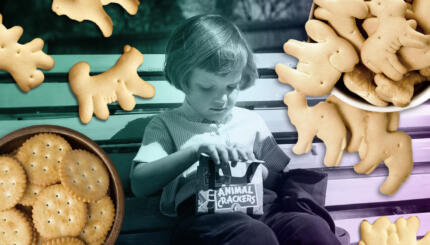We are rushing headlong toward winter break.
Soon my 9th graders will have time to reflect on the Torah they’ve learned this semester. The shelves will be emptied, and students will take home their Trash Art projects or return them to their original status.
All I ask is they toss them in the trash when I’m not looking.
This is my favorite art project in the Jewish Literature curriculum. I adapted it to be an end-of-unit assignment in fall 2015 after I’d team-taught an adult education course with local artist Flora Rosefsky, who originally designed the message-driven art project. The concept was simple: Using old cell phones, students would transform trash into a piece of art that conveyed their understanding of the Tower of Babel story. Together with the Jewish Studies and Fine Arts teachers at The Weber School, I’ve broadened the assignment, allowing students to show how they use technology to connect and communicate or to disconnect and isolate themselves from each other. We’ve encouraged students to use their own broken technology in their sculptures and partnered with local businesses that fix screens to supply us with their trash.
While most teenagers embrace this opportunity to express themselves, some balk at the assignment. We emphasize they’re not being graded on artistic ability but on their willingness to share their opinions about the uses and abuses of technology. We remind them the medium is forgiving: everyone who makes an effort can have success.
Every year, a few sculptures stand out, when a student creates art that challenges us to grapple with the world around us when the art expresses a message that cannot be ignored.
This year, it was Logan’s sculpture, entitled “The Leftover Shards of Social Media,” which caught the attention of every person who passed by the display.
Before putting the finishing touches on her piece, Logan calls me over to explain its message, which she later articulates in an artist statement. Her sculpture conveys,
“How being on social media with other people mirroring what the perfect image of a person [is] can hurt a person.” She writes honestly about the vulnerability and anxiety many people experience online: “When I look at other women on social media and I see how being skinny or how wearing makeup makes you get more likes and positive comments… I always begin to question myself and look in the mirror and compare myself to these women. Other girls go above and beyond to look the way these girls look. Cosmetic surgeries, tons of makeup, cutting, even as far as killing themselves because they don’t look the way the women online do.”
Logan wants to discuss her piece with me before writing about it, before embedding a CD shard into the wrist she has realistically fashioned from clay, to reassure me. While she intends for her art to make a bold statement about social media as a modern-day Tower of Babel that can make us feel disconnected from one another, it is not a personal plea for help. In her artist statement, Logan describes her artistic process before making a final observation:
“I used a broken CD that portrays a mirror because even though women or men don’t intend to, they always end up comparing themselves to these people online. I made a hand with cuts in the arm and a piece of the CD lodged in the arm to show the length these people go to make themselves perfect. In the end, we all are perfect and should love each other.”



